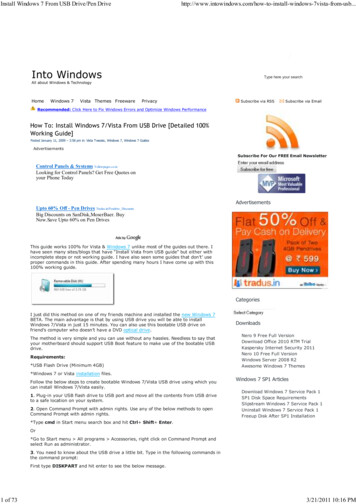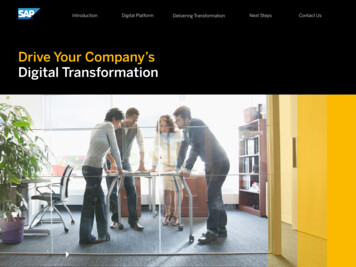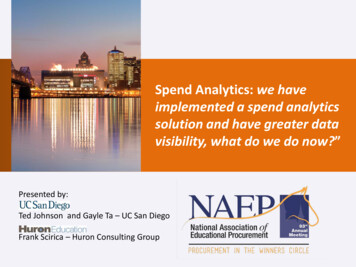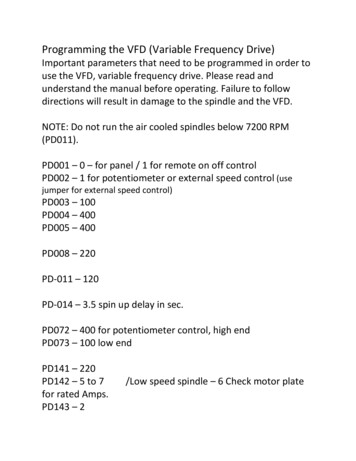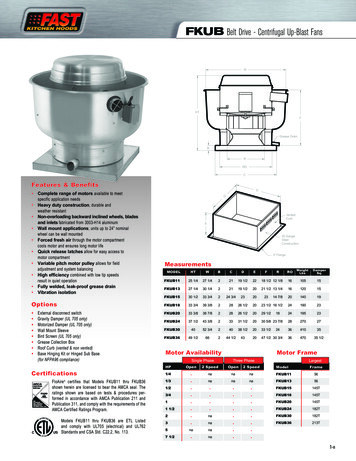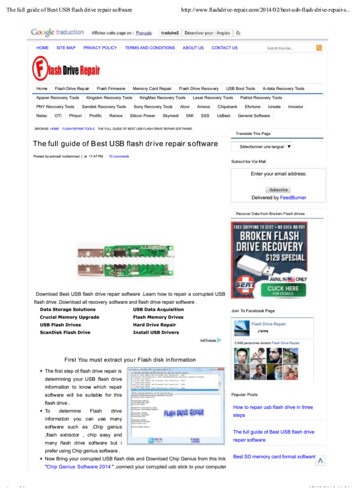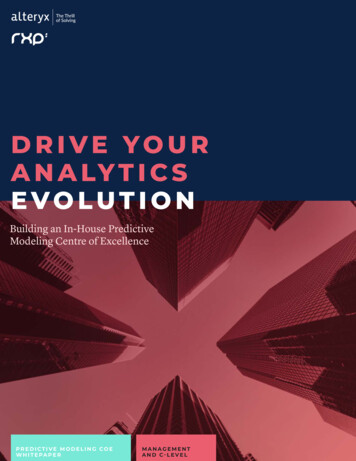
Transcription
DRIVE YOURA N A LY T I C SEVOLUTIONBuilding an In-House PredictiveModeling Centre of ExcellencePREDICTIVE MODELING COEWH I T E PA P E RMANAGEMENTAND C-LEVEL
“ The Alteryxplatform really isthe foundation ofstandardising ondata cataloging,data prep andblending, datacuration andmodeling,and modelmanagement anddeployment allat scale.”—Neil OsipukNational AlteryxCapability Lead, RXPAs data analytics spreadsthroughout your organisation, you’ll realise thebenefit from having a much greater understandingof your business processes. The capability to predictoutcomes improves and efficiency grows. But datascience is evolving at a tremendous pace, outstrippingthe capabilities of traditional analytics departments.With AI, machine learning, prescriptive and predictiveanalytics taking centre stage in this new analytics era,a modern vision is needed to ensure the organisationcan get the greatest possible benefit from these gamechanging analyses. You also need to reduce errors andincrease efficiency while providing data accuracy andsecurity. Business analysts need to evolve into “citizendata scientists” to bring their knowledge immediatelyto bear upon analytics problems.As users across the organisation become moreinvolved with analytics, benefits are magnified,but management and oversight can become morecomplex. An approach is needed that centralisesdata and analytics asset management, oversight,training, and security. The approach must actacross organisational boundaries, use cases anddepartments; integrate knowledge and expertisefrom both analysts and data scientists; and operateat a high enough level to ensure directives are carriedout. A solution can be found in the development of aPredictive Modeling Centre of Excellence (CoE). APredictive Modeling CoE adds higher-level modelingto the Analytics CoE, providing the additional supportneeded to serve the entire analytics spectrum and itstechnological and decision-making evolution.V I S I T A LT E R Y X . C O MDrive Your Analytics Evolution 2
Foundations of a Predictive Modeling Centre ofExcellenceA Predictive Modeling CoE is designed to: Develop a predictive analytics infrastructure andpipeline of model development Improve infrastructure and promote operationalefficiency by building a community driven byexcellence Promote collaboration and communication Provide training, consultation, guidance andsupport Promote best practices Implement an analytics and modellingmethodology framework Maximise return on investment (ROI) on yourCoE implementationThe Alteryx Platform is ideally suited toimplementing a Predictive Modeling CoE.Not only does it provide all of the capabilitiesneeded to manage and catalog analytics assets,but users can also prepare data for analysis,create models through to implementation,deployment and embedding of key analysis intobusiness processes. It is, moreover, a codefree and code-friendly solution that makes iteasy for data scientists to custom code in theirlanguage of choice, whether R or Python, andempowers citizen data scientists alike to activelycreate models via a drag-and-drop system. Mostimportantly, it permits rapid deployment ofthese models into production where they can beof real value.Drive Your Analytics Evolution 3L AY I N GTHEGROUNDWORK
The Alteryxplatform lets usersaccess real-timeresponses andmake changesto the modelsthey’re building.This automaticallycreates moretrust and visibilitybetween teams.With a platform established, implementing a Predictive Modeling CoE can beaccomplished through Alteryx partners such as RXP Services Ltd. in Australia.RXP’s team of consultants design holistic solutions, including Centres ofExcellence, within the Asia-Pacific region. Employing a proprietary Lean/Agileproject management methodology, using its subject-matter experts and theAlteryx platform, RXP has a successful track record of delivering complex digitaltransformations in some of the region’s largest corporations.“The Alteryx platform really is the foundation of standardising on data cataloging,data prep, and blending, data curation and modeling, and model management anddeployment all at scale,” says Neil Osipuk, National Alteryx Capability Lead at RXP.“It is the technological foundation that all of the processes a Predictive ModelingCoE will undertake are built on.”Building TrustYou need to establish trust to make predictive analytics work, and this demandsprocess transparency. People need to understand what data is being used, howit’s being used and how well prediction matches reality. This is a key area for thePredictive Modeling CoE. Trust demands teamwork, and teams need to worktogether. Building a relationship between the analytics team and business leadersdemands elimination of “black box analytic latency.” Traditionally, stakeholdersask a question, the data scientist disappears for a while and returns, the stakeholderfollows up with a secondary question and the cycle repeats. Because analytics isiterative, questions beget questions. Business leaders want answers that can betrusted and understood, but they also need a rapid exchange of results. The Alteryxplatform lets users access real-time responses and make changes to the modelsthey’re building. This automatically creates more trust and more visibility betweenthe two teams.“When business leaders say, ‘I don’t trust the information,’ or, ‘I don’t trust thispiece of analysis,’ more often than not what they’re actually saying is, ‘I don’tunderstand how you got to that conclusion,’” says Osipuk. “Being able to articulatehow you reached a conclusion and the assumptions made along the way provokesa real discussion. You can then discuss the results and the data. This is a high-valueconversation because you can change your analytic assumptions or fix the data. Ifyou provide transparency through leveraging solutions like the Alteryx Platform,people start to trust the process more because they understand the process.”Alteryx Connect provides complete data lineage so you can see where the datacomes from, what happened to the data and where it’s going. It provides an abstractview that helps to ensure the right people have the right access to the right data andare doing the right thing with it. This aids in building trust in the process, at the sametime providing process security. Automatic documentation also makes models easyto transfer to other users, or to understand them if someone leaves the group.Predictive Modeling CoE Design“In creating a Predictive Modeling CoE you need to focus first on the key questionsdriving interest in a CoE,” says Osipuk. “You need to create a problem statementthat can be transformed into a business case providing the potential ROI inimplementing the centre, as well as for use of predictive analytics. It’s importantto review issues such as interoperability with both IT and business, and ease ofdeployment.”A Predictive Modeling CoE differs from an ordinary Analytics CoE becausepredictive analytics focuses on modeling outcomes with its multiple iterationsand special data requirements, being fully informed of past events, near-currentV I S I T A LT E R Y X . C O MDrive Your Analytics Evolution 4
“ Bridging the gapbetween traditionalbusiness analystsand the new worldof data scienceis a key missionof a PredictiveModeling CoE”—Neil OsipukP R E D I C T I V E C A PA B I L I T I E S E XI S T T H AT A R E F U L LYI N F O R M E D O F PA S T E V E N T S , N E A R - C U R R E N T E V E N T SA N D M O D E L S O F R E L AT I O N S H I P S .WHATH I S T O R I C A L LYHAPPENS?WHAT JUSTHAPPENED?REAL-TIMEINTEGRATIONDATAWA R E H O U S I N GREPORTINGA N D A N A LY T I C SPROACTIVERESPONSEPREDICTIVEMODELINGWHAT-IFA N A LY S I SNational AlteryxCapability Lead, RXPWHAT ISABOUT TOHAPPEN?WHATMIGHTHAPPEN?events, and models of relationship. The CoE generally embraces the whole analyticsspectrum, but has special provisions for higher levels of analysis.In predictive analytics, data cleansing and preparation are also different from thoseof descriptive and lower-level analyses. This can take a lot of time and specialexpertise. Managing and preparing data correctly leads to fewer errors and greatertrust in results.Engaging the Citizen Data ScientistEngaging citizen data scientists is critical to a responsive analytics program. Thesebusiness analysts need real-time validation via visual indicators while they’re workingon the data to validate their analysis direction and results. Building confidence thatanalytics models are accurate is critical to Predictive Modeling CoE success. TheAlteryx Platform provides in-line visualytics within the actual workflow to allowbusiness users to see what’s happening with their data as they work with it, and changecourse of the analysis or make adjustments as they see what’s happening with theirdata. This helps them to build confidence in their ability to create sound insights.Prediction is at the high end of the analysis hierarchy of descriptive, diagnostic,predictive and then prescriptive approaches. Although very powerful for businessresults, it’s difficult to bring this capability within range of citizen data scientists.Empowering citizen data scientists for predictive analytics is just one-half of theequation. On the other hand, to enable experienced data scientists to pursue highvalue analysis and models such as prescriptive or machine learning you need to freethem from performing basic repetitive tasks. The Alteryx Platform makes it possibleto take those basic analytic tasks and put them on autopilot so they run seamlessly inthe background.“Bridging the gap between traditional business analysts and the new world of datascience is a key mission of a Predictive Modeling CoE,” says Osipuk. “It can energiseV I S I T A LT E R Y X . C O MDrive Your Analytics Evolution 5
and empower analytic users at all levels to take advantage of emerging capabilities.It takes them on a journey from data prep and blending into the advanced analyticscapabilities, and on to production with predictive models with Alteryx.”Finding ValueThe main point of predictive analytics is to answer a very specific value-finding orvalue-saving question. This is very different from descriptive analytics. The way thisoutput information is used within an organisation is also more varied. Visualisationscan be output to applications such as Tableau and Power BI, but there are otherways to consume analytics such as reporting, email, or quietly embedding it intobusiness processes. These processes might be internal or external, such as websitesor consumer-facing processes like the Netflix recommendation engine. In building aPredictive Modeling CoE, you need to recognise that the range of use cases for thesemodels is extremely wide. Your technology platform needs to be able to support thisbreadth of operation.“It’s also important to remember the value of predictive analytics, or of anyanalytics, is only achieved if people actually make decisions to change something orconsciously continue with something at the end of these processes,” says Osipuk.“Unless end users are empowered and enabled to do things differently, all we’redoing is producing numbers for the sake of producing numbers.”Analytics needs to actually empower change in an organisation rather than just beisolated outputs of a process. This is an important aspect of the Predictive ModelingCoE that goes beyond the technology alone; it must be an agent for cultural change,and help to engage predictive outputs with the business.GUIDINGPRINCIPLESSetting up a Predictive Modeling CoE requires a deep understanding of how yourbusiness is organised, its decision-making process and the environment in which itneeds to operate. RXP has a trusted program for discovering and encouraging thesecritical factors. It covers: Understanding the current decision-making process Asking the right questions Starting small and identifying project champions Complying with established data governance Quantifying ROIUnderstanding the Current Decision-Making ProcessPart of RXP’s initial engagement with clients is gaining an understanding of theircurrent maturity level with advanced analytics, and their overall data and analyticsenvironment. How decisions are made is critical in identifying your analytics needs.How your Predictive Modelling CoE is staffed, and its areas of concentration, needto match the data and analytics environment.V I S I T A LT E R Y X . C O MDrive Your Analytics Evolution 6
“ Starting smallwith a focusedproject, you candemonstrateROI as a way ofbuilding trustand confidencewith the keystakeholders andsponsors of theprogram.”—Stephen WayneNational Director, RXPAsking the Right QuestionsFor each query, you need to determine if this is a one-time question or needsongoing tracking. This is part of developing decision-making processes that ensureoptimal CoE operation. RXP provides a simple collaborative strategic planningexercise beginning with a single workshop. If you ask the right questions, youroutcomes will be more successful and you’ll achieve a better ROI. As an addedbonus, these efficiencies help to free up valuable time for data scientists andbusiness experts to focus on higher-value issues.Starting Small and Identifying Project ChampionsEstablishing stakeholder trust and confidence throughout CoE implementationprocesses through to its analytics results is critical. You need to view this in thesame way you would view any other complex business process. RXP understandsthe issues, and helps you with a gradual implementation. Starting small and movingforward as confidence builds helps to ensure continued executive buy-in. Supportfrom the top of your organisation is also important. You need to find executiveproject champions who can ensure the Predictive Modeling CoE has sufficientvisibility to retain interest and funding.Complying with Established Data GovernanceThe Predictive Modeling CoE initiative must comply with established datagovernance. Otherwise, chaos can ensue and there will be crossed signals overexpectations. You must establish a governance roadmap to engage and empowerthe data stewards. Governance should also be linked to change management inmoving to the new processes. RXP is experienced in guiding governance transitions,particularly in its impact upon jobs as “people” are a key focus of the PredictiveModeling CoE.Quantifying ROIRXP helps you to compare results and outcomes of the predictive model with previousdecision making. This is part of the company’s “secret sauce,” and makes it possible toquantify ROI for the CoE. A key factor in establishing ROI is to start small.“It’s like drilling for oil,” says Stephen Wayne, National Director at RXP. “You drilla lot of pilot holes until oil is struck. Then you set up your refinery and processesaround the discovery. In this case, oil is the business value. Starting small with afocused project, you can demonstrate ROI as a way of building trust and confidencewith the key stakeholders and sponsors of the program.”As with drilling for oil, it’s important for stakeholders to know that failure is also apart of the process. These are the pilot wells. Starting with small projects lets you failquickly and then move onto the next important question or to refine the question.V I S I T A LT E R Y X . C O MDrive Your Analytics Evolution 7
The PredictiveModeling CoE musttake responsibilityfor traininganalytics users andmonitoring analyticsoperations to ensurethey provide correct,consistent, andaccurate results.OPERATIONALCONSIDERATIONSYour Predictive Modeling CoE needs to unify practices and provide guidelinesfor analysis across boundaries of organisation and expertise. You need to setup processes that can be applied repeatedly to business cases throughout theorganisation, whether queries are initiated by data scientists or by citizen datascientists. The Predictive Modeling CoE must take responsibility for traininganalytics users and monitoring analytics operations to ensure they provide correct,consistent, and accurate results. RXP helps you with: Transforming the problem statement Defining and curating the right dataset and model Helping users use the solution appropriately Engineering the dataTransforming the Problem StatementAnalysts at any level of expertise need to transform the problem statement, businesscase, or high-level requirements into a series of questions or tests to be solved.Without knowing how to do this, you cannot understand what you’re looking for.This transformation simplifies the analytics process, provides clarity and permits thesolution to one question to help in solving another.Defining and Curating the Right Dataset and ModelPerhaps the most critical area for predictive analytics is defining and curating theright dataset and type of model to optimally solve questions. Decisions must also fallwithin business expectations around time taken, data availability, solution accuracy,error rates and applicable regulations. Citizen data scientists often require guidancehere, because these considerations differ from the ordinary expectations of business.Helping Users Use the SolutionHelping users maximise use of the solution is an important aspect of RXP’s consultingprocess. You need to have adequate training available for the software, as well asfor procedures within your organisation. RXP has conducted customised trainingprograms for major clients, which have included predictive analytics. Promotingknowledge sharing within the broader organisation and within external usercommunities is important. To meet that need, RXP has implemented internal usergroups to continue on with internal knowledge sharing and cross-training, as well asencouraging users to tap into the deep knowledge base of the Alteryx Community site.“Getting users up to speed with Alteryx is made easier by its user-friendly GUI,drag-and-drop operation, and focus on enabling the citizen data scientist while stillsupporting the more sophisticated user,” says Osipuk. “Alteryx also offers open coretraining modules from descriptive to predictive on a regular basis, so that people canself-educate and continue to upskill themselves easily and quickly.”Engineering the DataYou need to consider data engineering as a key infrastructure element in anyPredictive Modeling CoE. Every implementation takes place in a different dataV I S I T A LT E R Y X . C O MDrive Your Analytics Evolution 8
environment, and focuses on different types of questions. Location, storage and typesof data available can all be of importance. You need to look at important questions ofgovernance for the Predictive Modeling CoE. On the operational side, automatingand monitoring solution steps is part of the advisory role the Predictive Modeling CoEneeds to play in ensuring that analytics results are accurate and repeatable.T H I S I S A N A LY T I C STURNED UP TO ELEVENA LT E R YX C O N N E C TFind Analytic Assets and Amplify InsightsA LT E R YX D E S I G N E RBuild Repeatable Analytic WorkflowsA LT E R YX S E R V E RSchedule, Share, and Scale AnalyticsA LT E R YX P R O M O T EData Science Model Production SystemV I S I T A LT E R Y X . C O MDrive Your Analytics Evolution 9
RXP, Alteryx and Predictive Modeling CoEImplementation“For RXP one of the key reasons we choosepartners such as Alteryx is the ease of adoption ofthe technology,” says Paul Stewart, group managerof Sales at RXP. “These days, few businesses canafford the luxury of employing the huge codingteam needed to build and maintain a number ofcompetitive products. We find the ease-of-use,flexibility, and robust analytics features that theAlteryx platform provides make it an extremelyaccessible tool for citizen data scientists and aproductivity multiplier for trained data scientists.”At each decision-making level there areassociated cultural changes, processes,governance, modeling and technicalrequirements needed to support PredictiveModeling CoE
Alteryx platform, RXP has a successful track record of delivering complex digital . Predictive Modeling CoE, you need to recognise that the range of use cases for these models is extremely wide. Your technology platfo
